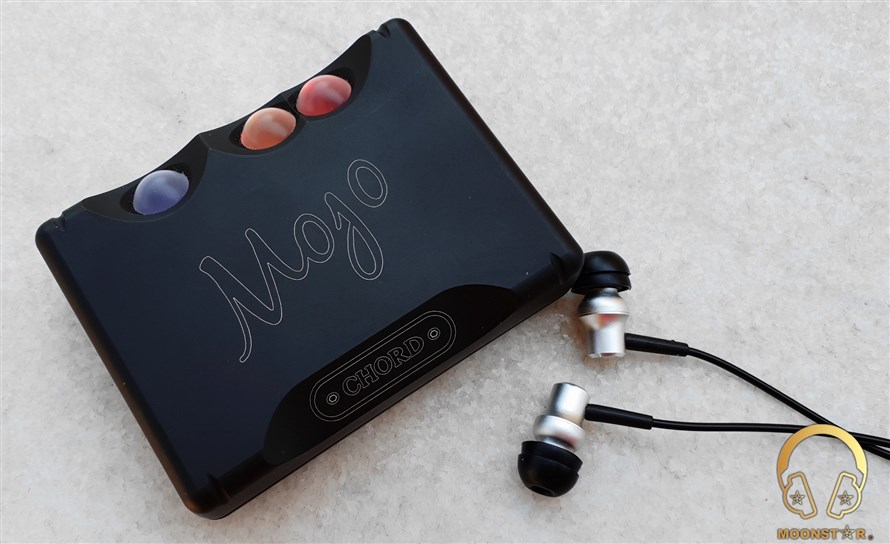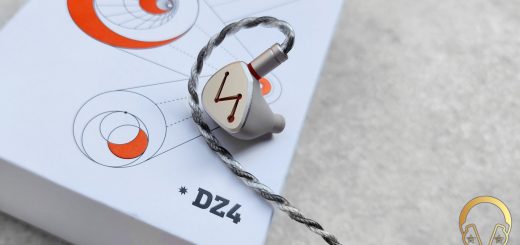FLC Technology FLC8N Review
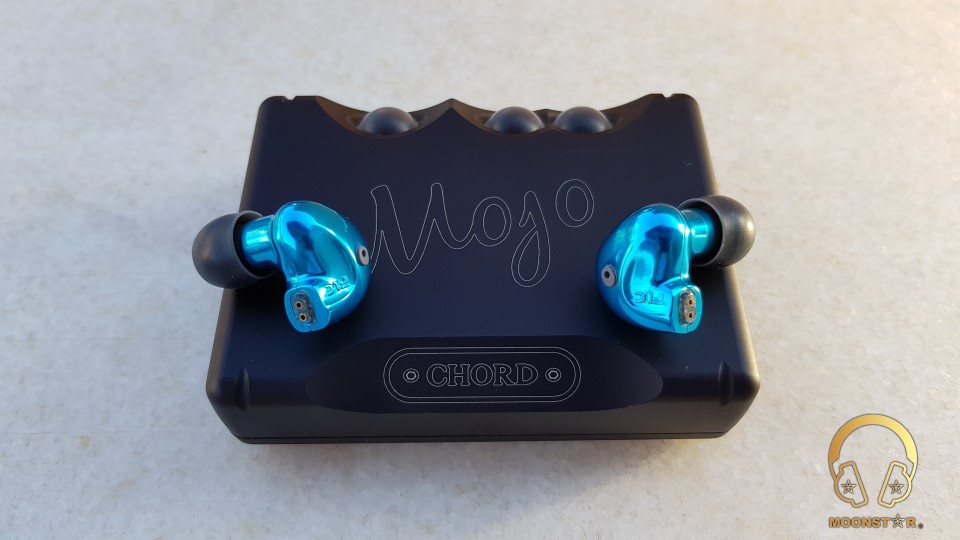
The FLC8N, a real Chameleon!
About FLC Technology:
FLC Technology Co. Ltd. is based in China and is committed to developing and producing high-end in-ear monitors (IEM) and custom in-ear monitors (CIEM). In 2011, FLC were one of the first companies in China to launch a hybrid CIEM.
The FLC 8 was there first hybrid IEM, featuring the ability to customize 36 different sound signatures to your liking, the FLC Technology FLC 8 came many nozzle filters and plugs. Now I want review the FLC 8N, which is one of their latest product together with the FLC 8D and FLC Celeste.
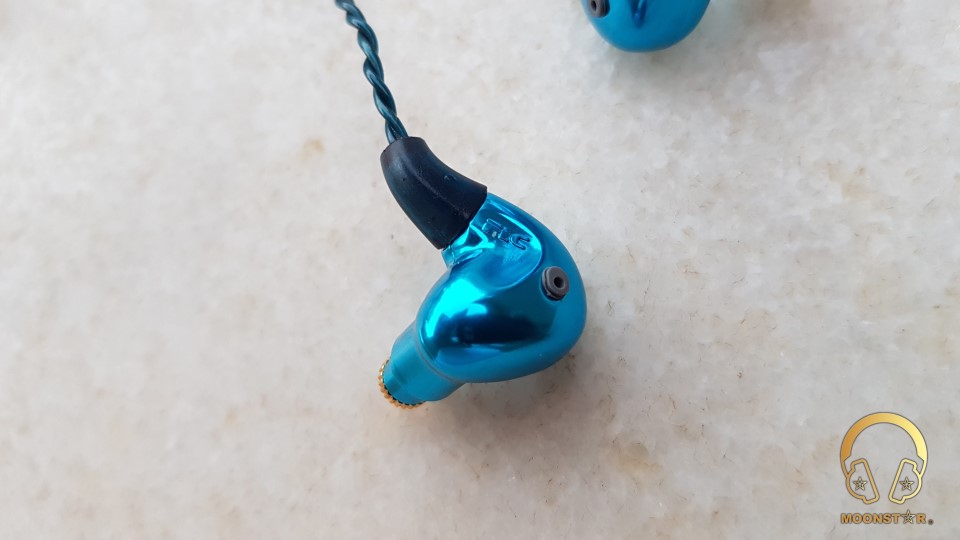
Disclaimer:
The FLC 8N IEM was provided to me by FLC Technology via Lend Me UR Ears as a review sample. I am not affiliated with FLC Technology or Lend Me UR Ears and any third person beyond this review and all these words reflect my true, unaltered, opinions about the product.
The Price:
The FLC 8N has an official MSRP of USD 355 and can be found under the following purchase link;
Purchase link: http://www.lendmeurears.com/flc8n/
Package and Accessories:
The FLC 8N came in a light brown cardboard box, which sports a silver printed FLC Logo. This box has a magnetized cover and a folding system, which is separated in to partitions. At the first partitions you can find the FLC 8N monitors buried in to a yellow foam mold. At the second partitions you can find the following accessories;
- 1 pcs x 2.5mm Balanced or 3.5mm Single Ended 2 Pin Cable (depends on your order)
- 8 pairs x Silicone Eartips (Each two pairs of L/M/S/Ultra-S size)
- 9 pcs x Bass tuning plugs 3 sorts x 3 pcs)
- 9 pcs x Sub-bass tuning plugs (3 sorts x 3 pcs)
- 4 pcs x Midrange & Treble tuning filters
- 1 pcs x Tuning accessories box
- 1 pcs x Tweezer
- 1 pcs x Earwax cleaning tool
- 1 pcs x 1/4″ to 3.5mm Adapter
- 1 pcs x Airplane earphone adapter
- 1 pcs x Shirt Clips
- 1 pcs x Metal Hard Case
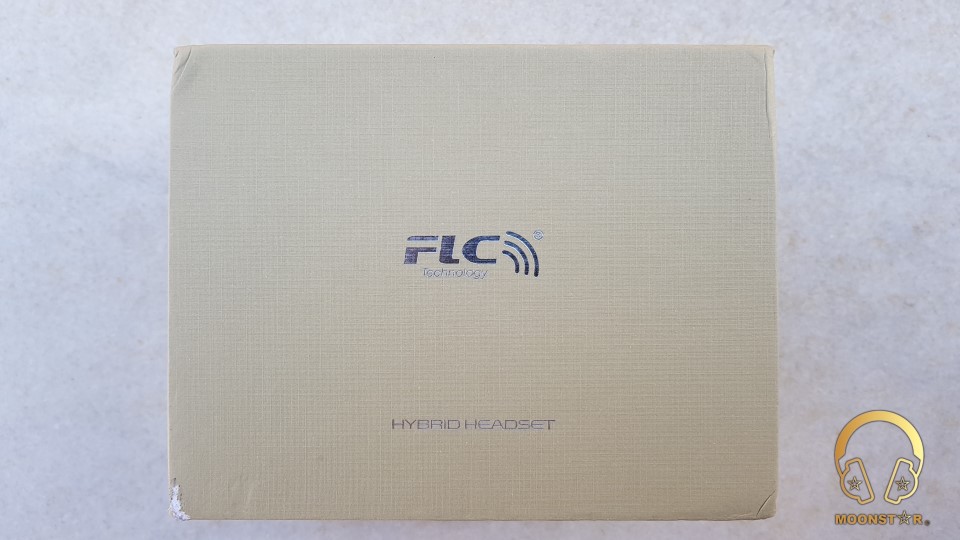

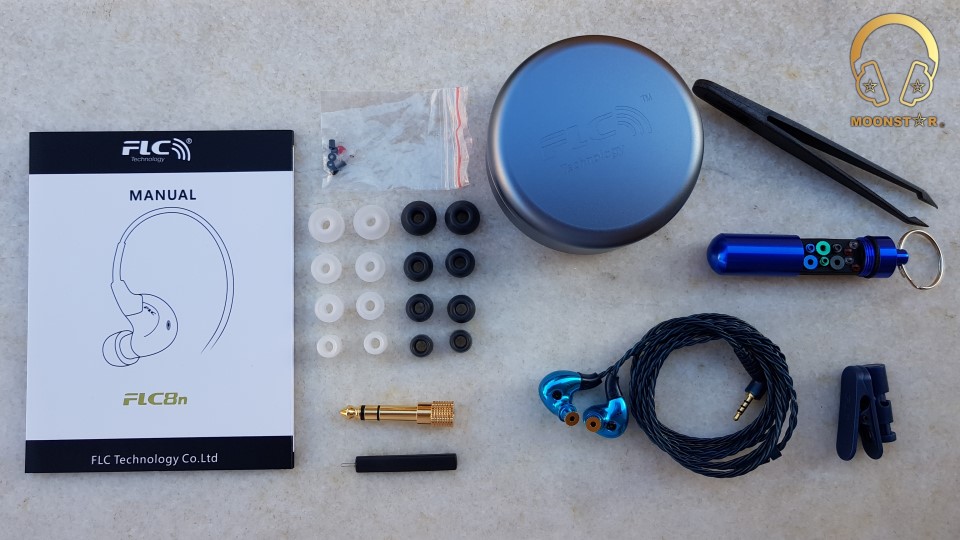
The metal case that is included to the box looks pretty stylish and has a velvet inner coating, which should protect the FLC 8N from possible impacts and scratches.
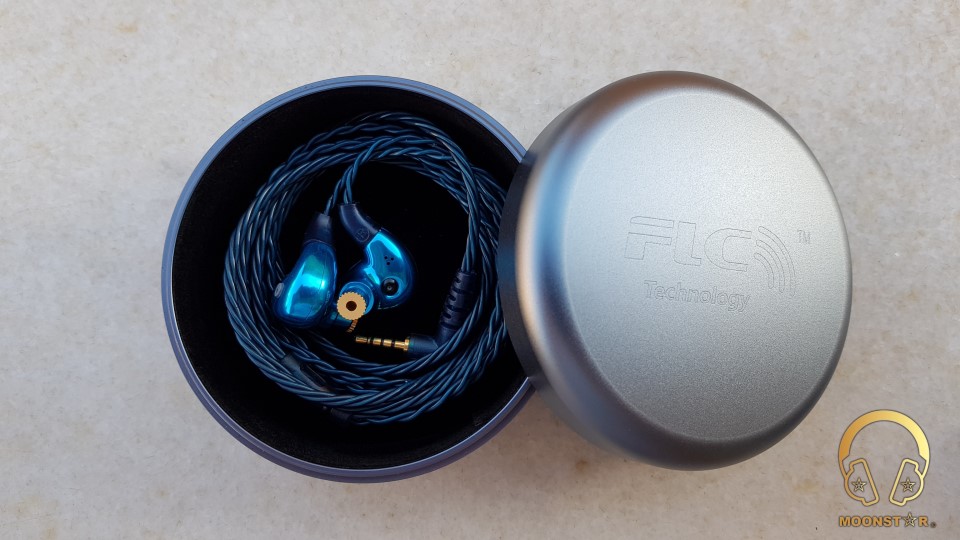
There is also a metal capsule in blue color with a screw system and a key ring, where you can find 9 pcs (3 sorts x 3 pcs) of Bass Tuning Plugs, 9 pcs of Sub-bass Tuning Plugs (3 sorts x 3 pcs) and 4 pcs of screwable Nozzle Tuning Filter, which I will explain more detailed under the sounds article.
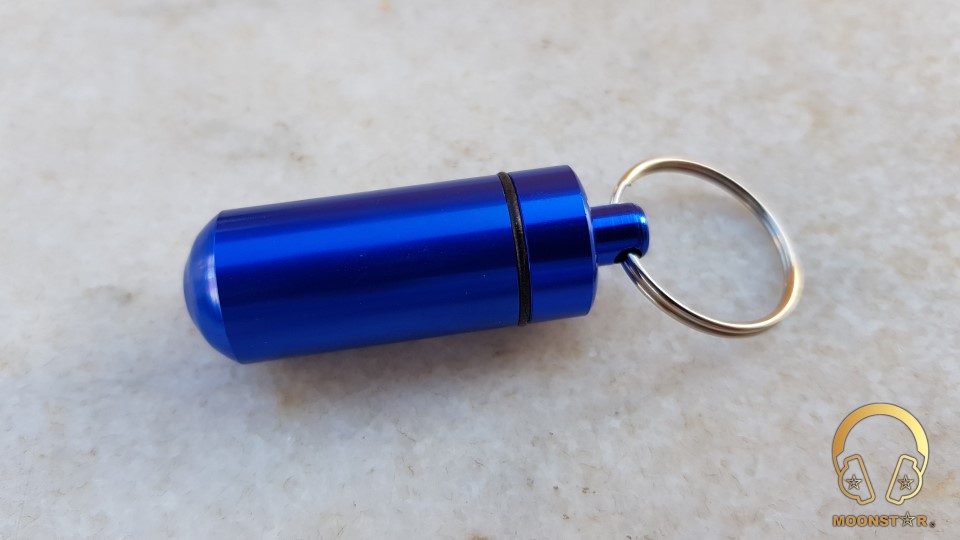
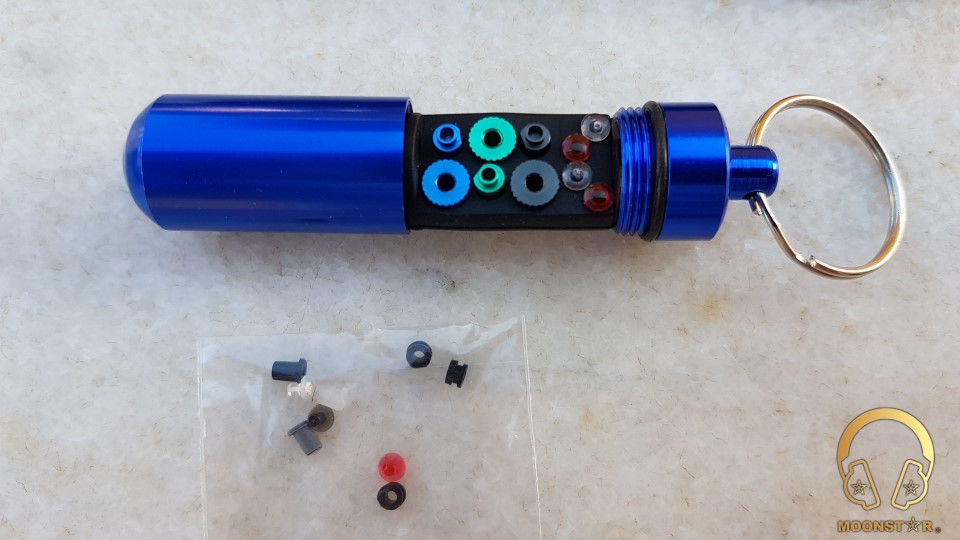
The box is also including a Shirt Clips, Tweezer, 1/4″ to 3.5mm Adapter and Earwax cleaning tool, which are a nice additional.
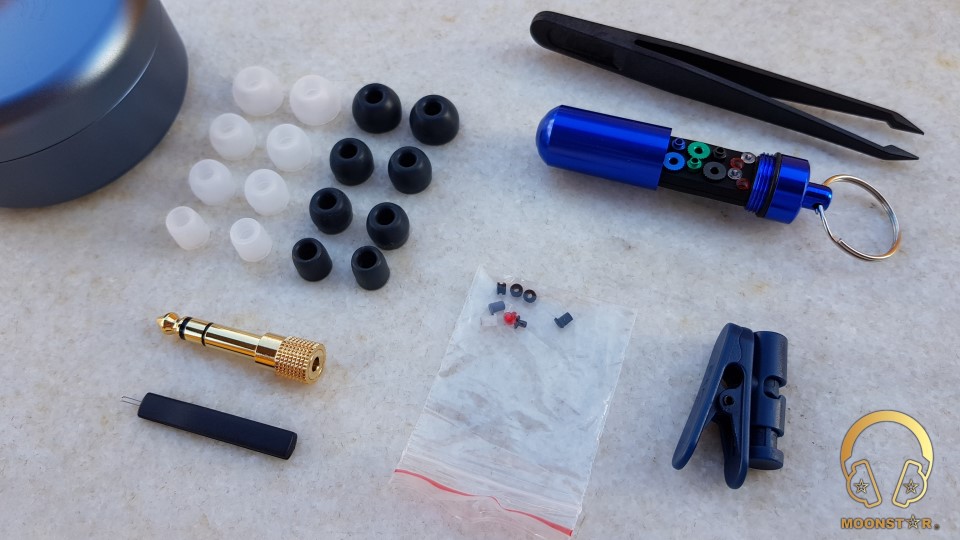
The Cable:
According to FLC Technology Specs; the FLC 8N comes with a 4 core braided 7N crystal copper wire with a purity of 99.99998%. This cable was produced by a self-designed special weaving machine, which is providing no welding in the cable, to ensure that the signal is lossless during the transmission process.
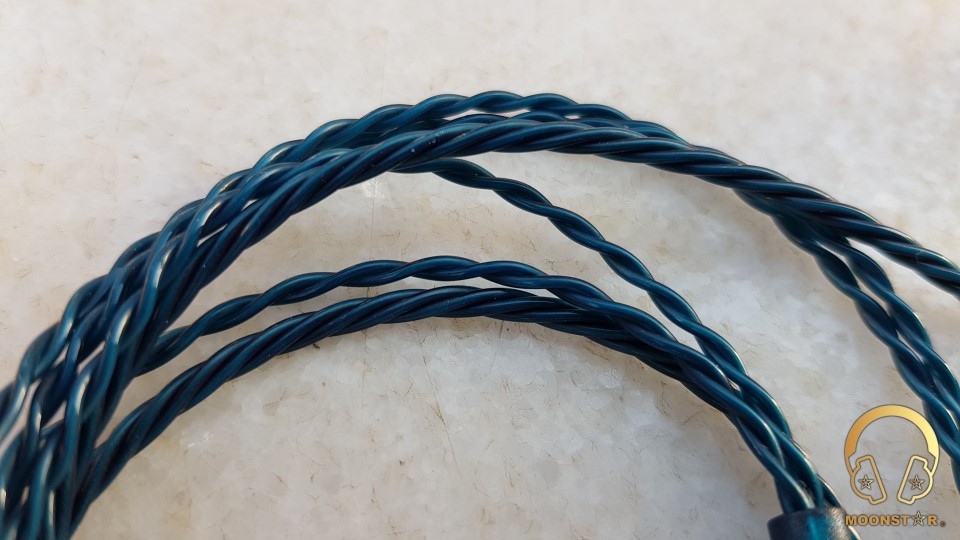
The Cable has a nice blue colored plastic coating with relative low microphonic effects.
This cable has 0.78mm male connectors and a right angled 2.5mm Balanced or 3.5mm Single Ended Headphone Jack depending of your purchase.
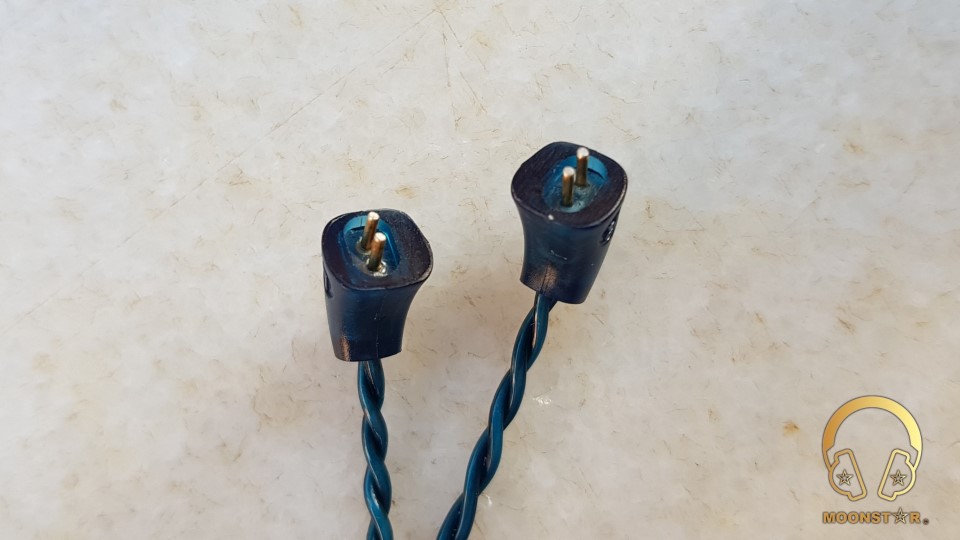
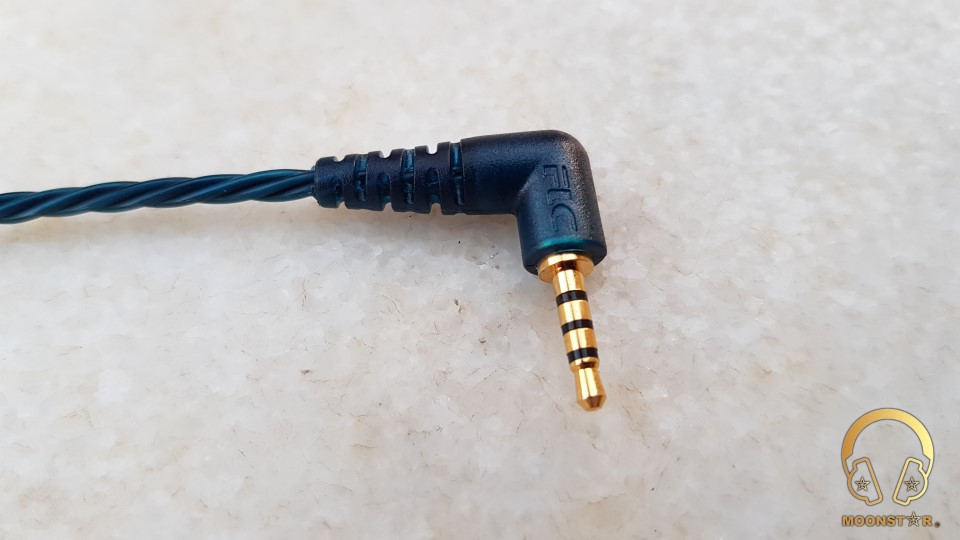
The cable sports a chin slider and a y splitter that are made of plastic.
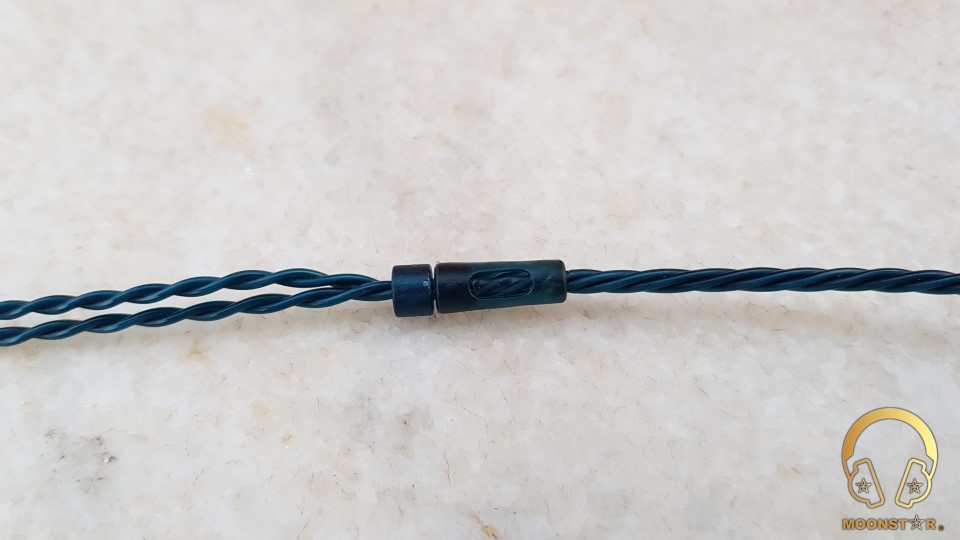
All in all, the cable and its connecter are looking rock solid and should last for years.
Design, Fit and Build Quality:
The housing of the FLC 8N is made of CNC machined metal which looks and feels very durable in my hands. The shell has a turquoise blue metallic/reflective painting, which has a pretty nice appearance.
On the front is the FLC Logo and the sub-bass port where you can put in the one of the 3 sorts of sound tuning plugs.
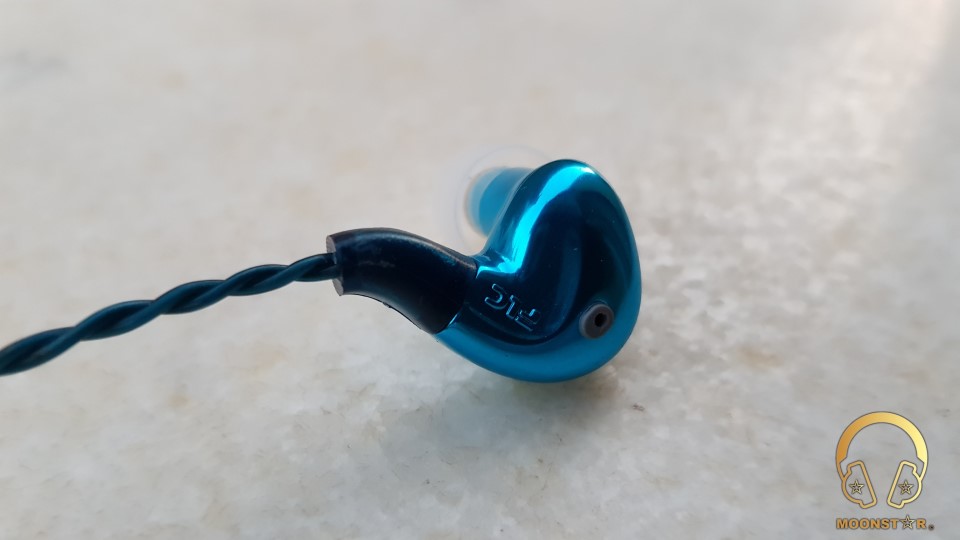
On the rear is the sound Nozzle where you can screw in 4 types of sound filters for midrange & treble tuning and 3 mini holes which are serving for bass ventilation. There is also the bass port where you can put 3 sorts of sound tuning plugs.
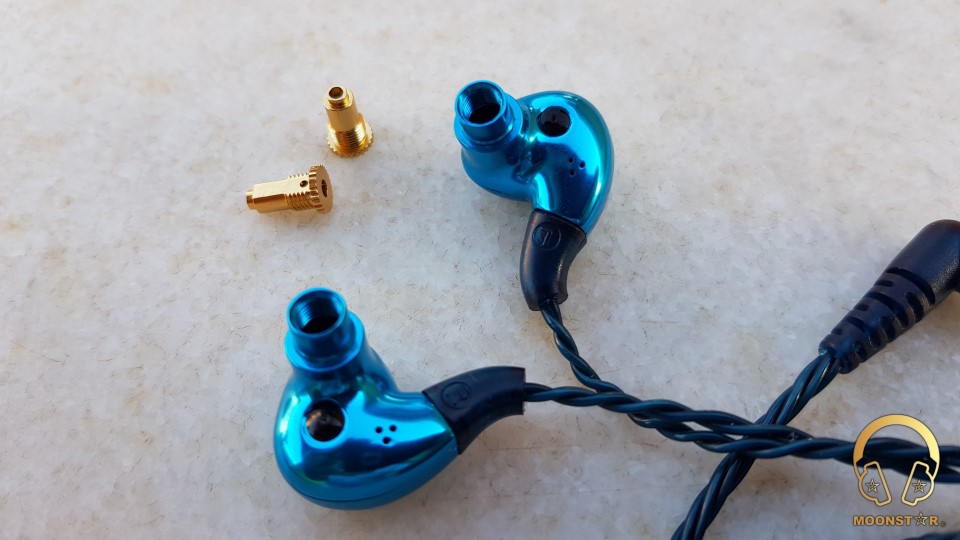
On the Top is the 0,78mm female plug, where you can attach your upgrade cable with 2pin male connectors.
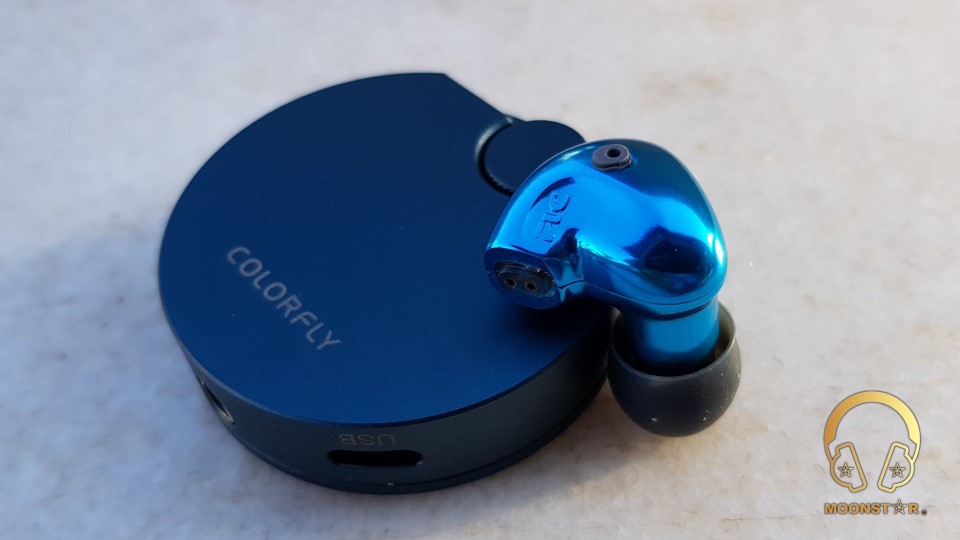
The FLC 8N is a very comfortable In-Ear Monitor that can be worn for hours without to be uncomfortable or to hurt your ears. The isolation of the 8N is above average and is good enough to use it in environments like bus, metro or train.
Technical Specifications:
- Driver : Hybrid Driver 1 x 8.6mm Dynamic Driver + 2 x Balanced Armature
- Sensitivity : 107dB / mW, 1000Hz
- Frequency Response : 20-20KHz
- Impedance : 11 Ohm
- Connector : 0.78mm
- Cable Length : 1.2 Meters
- Plug : 2.5mm Balanced or 3.5mm Single Ended Plug with Gold Plating
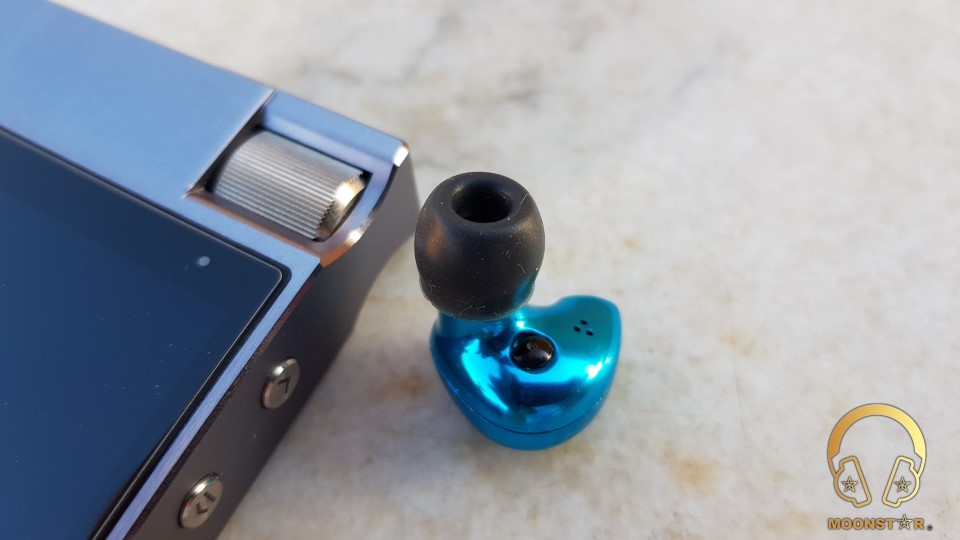
Drivability/Sensitivity:
The FLC 8N is a sensitive and efficient In-Ear Monitor with a relative low impedance of the 11 ohm’s. The FLC 8N is an ideal IEM for the use with portable sources like Smartphones, Tablet’s, etc. and can be driven to very loud volumes without the need of an external amplifier.
Sources:
a) In Ear Monitor : FLC Technology FLC 8N, Oriolus Forsteni
b) DAP/DAC : Cayin N5II, Chord Mojo, Hifiman HM603s, Colorfly CT-C1
c) Albums & Tracks used for this review:
- Steve Srauss – Mr. Bones (Flac 16bit/44kHz)
- Dire Straits – Money for Nothing (DSD 64)
- GoGo Penguin – Fanfares (Tidal Hi-Fi)
- Casey Abrams – Robot Lover (Tidal Hi-Fi)
- Jehan Barbur – Yollar (Spotify)
- Minor Empire – Bulbulum Altin Kafeste (Spotify)
- London Grammar – Interlud (Live) (Flac 24bit/44kHz)
- Laura Pergolizzi – Lost On You “Live at Harvard and Stone” (Tidal Hi-Fi)
- Morbid Angel – Drum Check (Spotify)
- Charly Antolini’s – Duwadjuwandadu (Tidal Hi-Fi)
- Liquid Tension Experiment 2 – Acid Rain (Spotify)
- Megadeth – Sweating Bullets (Flac 16bit/44kHz)
- Future Heroes – Another World (Tidal Hi-fi)
- Lorde – Team (Flac 24bit/48kHz)
- Tom Player – Resonace Theory “Album” (Tidal Hi-Fi)
- Deeperise feat. Jabbar – Move On (Spotify)

Sound Analysis and Tuning Options:
The main sound character of the FLC 8N could be described as follows;
The FLC 8N is an In-Ear Monitor with a fast and deep bass response that has a warm and bodied midrange with a slightly laid back character, which is combined with a vivid and airy treble presentation.
The FLC 8N has a 3-way filter system that lets you vary the sound. This means that you have a choice between 36 different sound signatures.
The FLC 8N has 4 Nozzle Filters, 3 Front and 3 Rear plugs. The screw in nozzle fitters are chancing the midrange and the treble response, the small plastic plugs for the inner port are responsible for the sub-bass frequencies, and the outer port tune plugs are for the bass variation.
Now I would like to inform some short details about these filters and plugs.
Nozzle Filters (Midrange and Treble):
- Golden: Most mid-frequency and medium high frequency
- Blue: Less mid-frequency and less high frequency
- Green: Medium mid-frequency and most high frequency
- Gunmetal: Medium mid-frequency and medium high frequency
Front Plugs (Sub-bass):
- Transparent: Less ultra-low frequency
- Gunmetal: Medium ultra-low frequency
- Red: Most ultra-low frequency
Rear Plugs (Bass):
- White: Less low frequency
- Grey: Medium low frequency
- Black: Most low frequency
In fact, the sound is changing, but the main sound character remains in most cases the same.
Here is a Frequency chart of the FLC 8N:
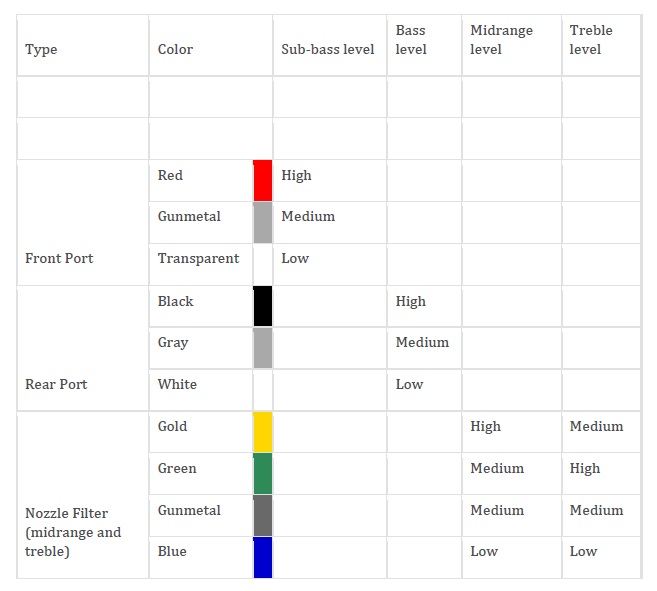
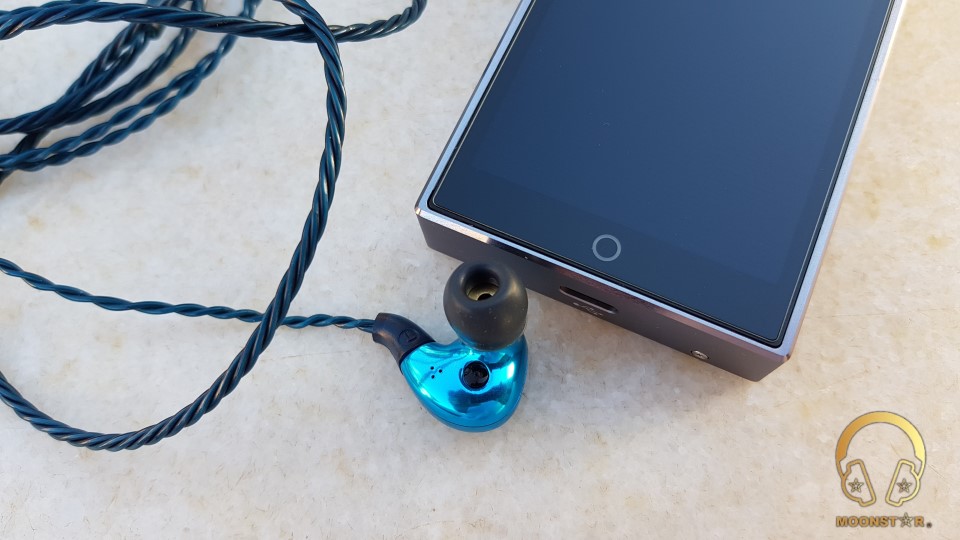
The Sound:
Bass (Front & Rear Plug):
The bass of the FLC 8N are sharing in general a good depth impact and speed. The bass amount and character can be chanced form relative neutral to nearly bass head levels, by using different type of filter combinations.
Front pugs (Sub-Bass):
As I mentioned above, there are the Red, Gunmetal and Transparent sub-bass plugs.
The Red plug is reaching to the maximum depth followed by the Gunmetal and Transparent ones. The Red plug is superior to the other plug related to sub-bass amount, extension and depth. The sub-bass emphasis is very strong and noticeable with the Red plug.
The combination of Red Front + Black Rear + Golden Nozzle filter makes the FLC 8N ideal for the listening of genres like Pop, EDM or Trance.
If you combine the same plugs with the Gunmetal filter, you will get more balanced tuning with a pretty controlled and clean bass presentation, which should be ideal for acoustic, metal and genres like jazz, with the expiation of bass heavy tracks.
The transparent front plug has the least sub-bass quantity that could more ideal for those who like a linear bass presentation like the Etymotic er4s.
A combination of Gold Filter + Transparent front plug + White rear plug is ideal for vocal lovers.
Rear Plugs (Bass):
As I mentioned before, the FLC 8N has 3 bass plugs that are in White, Grey and Black colors.
The black one has the strongest bass emphasis, followed by the grey and white plug. The grey plug has the most detailed and refinement bass presentation of all, while the white plug shares a more linear bass response.
You will archive the highest bass quantity when you combine the black rear plug with the red front plug. This combo will satisfy most bass lovers, with the exception of people who prefer a more analytical bass presentation.
The black plug has in general a hard hitting, strong and full bodied bass presentation. The bass speed is above average and is pretty tight, which is a positive ability of this plug. But the black plug is inferior in terms of bass refinement, speed, detail and control.
The grey rear plug is adding the FLC 8N a more balanced, refined and clean bass presentation, which should also quantity wise enough for genres like metal, jazz and acoustic music.
The Grey filter is superior to the black and white plug in terms of speed control and detail, but is inferior in terms of quantity and tightness.
The bass characteristics of the white filter is linear and more on the analytical side. The white plug is ideal when you combine it with the gold front filter and transparent front plug.
Midrange (Nozzle Filter):
As I mentioned before, there are 4 Nozzle Filters (Gold, Gunmetal, Blue and Green), which we can be mount on the nozzle of the FLC 8N. This filters are chancing the midrange and treble range character of the FLC 8N that I will now explain for you with comparisons.
The Gold Filter:
The Gold filter will especially satisfy people who prefer an upfront midrange and vocal presentation. This filter has a clean, full bodied, transparent and detailed midrange performance, where vocals are positioned one step behind of the instruments. The gold filter performs also very well in terms of vocal and instrument separation, without any remarkable mixing. This filter represents vocals in a transparent and slightly warm way, without to be too soft or harsh. Another positive feature of the gold filter is that although the vocals are pretty upfront, that there is no sibilance or muddiness.
Both male and female vocals are a sharing great detail performance, while male vocals have good depth and female voices a soft and fairly full bodied presentation.
Due to the fairly balanced sound reproduction, both thin and thickly accented string instruments sounding very natural with the golden filter.
The Gold filter is superior to all other filter in terms of detail, airiness and for vocal/instrument performance.
The Gunmetal Filter:
The Gunmetal filter sounds in general pretty balanced and has a lightly more laidback presentation than those of the Gold filter, which could be preferred by those who like a laidback presentation. Those sound character makes the Gunmetal filter ideal for longer listening periods.
When it come to the vocal performance, both female and male are pretty equal in performance. This filter sound slightly more neutral in the midrange than the Gold filter that has a slightly warmer presentation. The detail level and separation of instruments is also on a good level. This filter could be preferred by those who like a more analytical and neutral presentation than the Gold filter.
The detail level of the Gunmetal filter is slightly inferior in performance, when we compare it with the Gold filter, but is superior to the Green a Blue filter.
The Green Filter:
The Green filter has a brighter and stronger upper treble presentation, which makes it less neutral and ideal for long listening periods than the Gunmetal and Gold Filter. But this character makes the overall presentation of the midrange airier and spacious than the Gunmetal and Gold filter.
The Green filter need needs absolutely good recorded/mastered tracks, to show its potation. This ability makes it less forgiving and prone to sibilance and harshness than the Gold and Gunmetal filter.
The vocal presentation of the Green filter sounds in general thinner and brighter and makes it less enjoyable for listening vocals than the Gunmetal and Gold filter, but shows one of the best acoustic guitar performance of all other filters. Thin stringed instruments performing better than those thicker stings.
The midrange of the Green filter is superior to the Gold and Gunmetal filter in terms of airiness and midrange space, but this tuning makes it less natural, bodied, warm and emotional than the Gunmetal and Gold filter.
The Blue Filter:
The midrange of the Blue filter sounds the leanest of the nozzle filters. This filter is the most recessed sounding filter in terms of instrument and vocals positioning. The midrange of the blue filter is not very bright and airy than the other ones and you can feel that there is missing some detail and transparency due the slightly veiled presentation.
The good thing about the Blue filter is that it doesn’t sound harsh and is forgiving regarding to bad recorded/mastered tracks.
The Treble Range:
The FLC 8N has many filter option that affect the sound signature, especially the treble range, which makes the filter selection for each music genre even more important. The selection of a wrong filter can possibly cause an unwanted sound performance.
For Example; The Green filter doesn’t fit modern genres like pop or rock due the relative bright nature, but sound pretty detailed, airy and spacious with genres like classical music.
The Gunmetal and Gold filter are providing a pretty bright and energetic sound signature, without to be sibilant or harsh in the treble range.
The Blue filter is reducing the treble quantity the green is offering brightness but in cost of some sibilance.
Gold filter is offering a balanced a quite natural treble presentation, without any unnatural peak. The treble extension of the Gold filter is superior to the Blue filter, but inferior to the Gunmetal and Green Nozzle filters.
The Gunmetal filter sounds slightly more detailed and emphasized than the Gold filter, while the treble quantity and extension of the Gunmetal is superior to the Blue, but inferior to the Green filters.
The treble range of the Green filter sounds a bit bright and sibilant with genres except classical music, but is superior to all other filters in terms of detail and treble extension. I have noticed that the treble range of the Green filter sounds slightly unnatural, metallic and cold compared to the Gold and Gunmetal filter.
The Blue filter has less treble quantity and extensions than all other filter, but is ideal for those who have treble sensitivity and are looking for a treble tuning, which is ideal for long listening periods.
Soundstage:
The soundstage of the FLC 8N is not ultra-expansive or deep like some TOTL IEM’s on the market, but it shares a nice sense of wideness and depth, which will satisfy most users, especially for the price that is asked for the FLC 8N. The soundstage is wider than its depth and sounds pretty spacious and airy in its presentation.
The background is quite black and there is enough space for lots of instruments, without any remarkable interference, even in complex passages with lots of instruments.
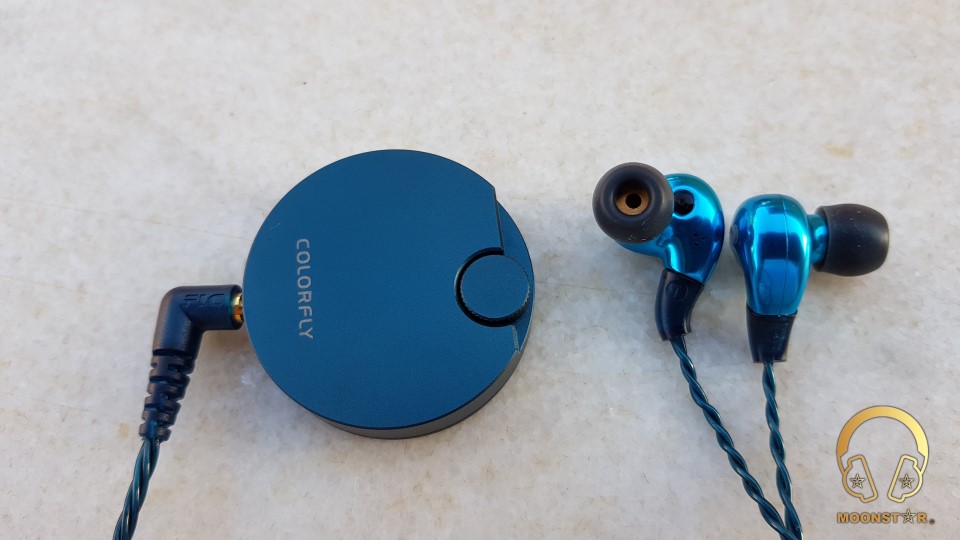
FLC 8N versus Oriolus Forsteni
Both IEMs sharing a similar price and Hybrid driver configuration of 2 Balanced Armature and 1 Dynamic driver. The Oriolus Forsteni has a V Shaped sound signature with pretty neutral tonality, while the FLC 8N can sound laidback, neutral, slightly warm or full bodied depending on the Filter/Plugs that are used.
The Oriolus Forsteni has a moderate quantity of sub-bass impact and an average bass emphasis, while the FLC 8N is more flexible and has more sub-bass quantity, depth and linear bass performance depending of the filter/plug that is used.
The FLC 8N is superior to the Oriolus Forsteni in terms of bass depth, quantity and emphasis. The Oriolus Forsteni has only better in bass performance, when I have used the white and transparent rear plugs, while both IEM’s sharing a great bass control and speed in this price range.
The midrange of the Oriolus Forsteni sounds a bit recessed due the V shaped sound signature, while the FLC 8N has the ability to make the midrange sound recessed or more upfront depending the filter you are using with it.
The midrange of the Forsteni sounds neutral and a bit dry to dry for my taste, while the midrange of the 8N sounds warmer, more musical and full bodied. What is particularly noticeable is that the detail rendering of the FLC 8N is superior to the Oriolus Forsteni.
The overall midrange detail of the Oriolus Forsteni is superior to the FLC 8N, if you use the Green and Blue nozzle filters, but is inferior to the Gunmetal and Gold filters of the 8N.
The treble range of both IEM’s sounds energetic, vivid and with good extension. The Oriolus Forsteni has the upper hand for treble quantity and extension, except the Green filter of the FLC 8N.
The FLC 8N performs better in terms of treble control, while the Green filter of the 8N makes the sound airier and spacious than the Forsteni.
When it comes to the soundstage performance, both have its own strengths. The Oriolus Forsteni has a slightly wider soundstage, while the FLC 8N performs better for depth. Both the Forsteni and the 8N have a quite spacious and airy presentation, while the FLC 8N is slightly more accurate for instrument positioning.
Conclusion:
The FLC Technology FLC 8N is like a Chameleon with its great sound tuning ability, which is not a truly gimmick! The detail level is the best I have heard from any In-Ear Monitor in this price category and the beautiful midrange presentation and solid build quality makes it one of my new favorites under the $500 USD barrier.
Highly recommended!
Pros and Cons:
- + Wonderful detail level and beautiful midrange presentation (Gold Filter)
- + Great Bass response, nearly on a bass-head level with the right plug combination
- + Lots of sound and fine-tune options
- + Nice accessories package
- + Good comfort
- – Tuning plugs are very small, which needs extra attention
- – The chancing of the small tuning plugs need sensitivity


